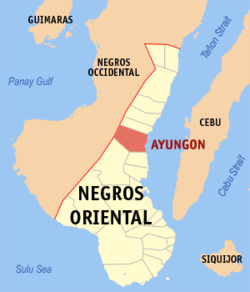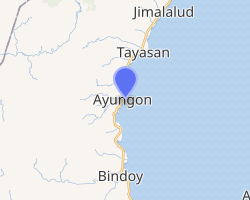Ayungon
Ayungon, officially the Municipality of Ayungon, is a 2nd class municipality in the province of Negros Oriental, Philippines. According to the 2015 census, it has a population of 46,303 people.[3]
Ayungon | |
|---|---|
| Municipality of Ayungon | |
 Map of Negros Oriental with Ayungon highlighted | |
OpenStreetMap 
| |
.svg.png) Ayungon Location within the Philippines | |
| Coordinates: 9°51′30″N 123°08′48″E | |
| Country | |
| Region | Central Visayas (Region VII) |
| Province | Negros Oriental |
| District | 1st district |
| Barangays | 24 (see Barangays) |
| Government | |
| • Type | Sangguniang Bayan |
| • Mayor | Emarie F. Agustino |
| • Vice Mayor | Nelda A. Favillaran |
| • Congressman | Jocelyn S. Limkaichong |
| • Electorate | 29,181 voters (2019) |
| Area | |
| • Total | 265.10 km2 (102.36 sq mi) |
| Population (2015 census)[3] | |
| • Total | 46,303 |
| • Density | 170/km2 (450/sq mi) |
| • Households | 10,412 |
| Economy | |
| • Income class | 2nd municipal income class |
| • Poverty incidence | 52.41% (2015)[4] |
| • Revenue (₱) | 124,399,314.37 (2016) |
| Time zone | UTC+8 (PST) |
| ZIP code | 6210 |
| PSGC | |
| IDD : area code | +63 (0)35 |
| Climate type | tropical climate |
| Native languages | Cebuano Tagalog |
| Website | www |
History
It is said that Ayungon is derived from the name of a deaf man, “Ayung,” who cut down a “dungon” tree. Old municipal profiles refer to Ayungon as Todos los Santos though there are no legends to explain that Hispanic name, just as there are no tales elaborating on the ruins of apparently Hispanic fortifications on the Tampocon II shoreline, perhaps because Ayungon's colonial past was not entirely its own: for many years it was a mere barrio of Tayasan, until 1924 when Governor General Leonard Wood came to establish Ayungon as a full-fledged municipality.
Although firing up its economic dynamos to catch up with provincial developments, Ayungon retains its rural charm through vast and scenic rice fields, dense coconut groves and expansive plantations of sugar cane, bananas and pineapple.
Of only three virgin forests said to be still remaining on Negros Island, one is located in Banban, Ayungon. Nature lovers will be regaled by sightings in the Karalaon Bird Sanctuary, the subterranean drama of the Mabato Caves, and the postcard-pretty Pagsalsalan Twin Falls.
Ayungon is located on the midriff of Oriental Negros’ northern stretch, approximately two hours from Dumaguete City.[5]
Barangays
.png)
Ayungon is politically subdivided into 24 barangays.
- Amdus
- Anibong
- Atabay
- Awa-an
- Ban-ban
- Calagcalag
- Candana-ay
- Carol-an
- Gomentoc
- Inacban
- Iniban
- Jandalamanon
- Kilaban
- Lamigan
- Maaslum
- Mabato
- Manogtong
- Nabhang
- Poblacion
- Tambo
- Tampocon I
- Tampocon II
- Tibyawan
- Tiguib
Climate
| Climate data for Ayungon, Negros Oriental | |||||||||||||
|---|---|---|---|---|---|---|---|---|---|---|---|---|---|
| Month | Jan | Feb | Mar | Apr | May | Jun | Jul | Aug | Sep | Oct | Nov | Dec | Year |
| Average high °C (°F) | 29 (84) |
30 (86) |
31 (88) |
32 (90) |
31 (88) |
30 (86) |
30 (86) |
30 (86) |
30 (86) |
30 (86) |
29 (84) |
29 (84) |
30 (86) |
| Average low °C (°F) | 23 (73) |
22 (72) |
23 (73) |
24 (75) |
25 (77) |
25 (77) |
25 (77) |
25 (77) |
25 (77) |
24 (75) |
24 (75) |
23 (73) |
24 (75) |
| Average precipitation mm (inches) | 42 (1.7) |
34 (1.3) |
40 (1.6) |
61 (2.4) |
124 (4.9) |
188 (7.4) |
190 (7.5) |
191 (7.5) |
189 (7.4) |
186 (7.3) |
124 (4.9) |
73 (2.9) |
1,442 (56.8) |
| Average rainy days | 10.0 | 8.5 | 9.5 | 12.8 | 22.3 | 26.8 | 28.4 | 27.9 | 27.3 | 27.6 | 20.5 | 13.1 | 234.7 |
| Source: Meteoblue [6] | |||||||||||||
Demographics
| Year | Pop. | ±% p.a. |
|---|---|---|
| 1939 | 12,777 | — |
| 1948 | 14,797 | +1.64% |
| 1960 | 21,539 | +3.18% |
| 1970 | 23,165 | +0.73% |
| 1975 | 23,639 | +0.41% |
| 1980 | 27,656 | +3.19% |
| 1990 | 33,317 | +1.88% |
| 1995 | 36,928 | +1.95% |
| 2000 | 40,744 | +2.13% |
| 2007 | 42,643 | +0.63% |
| 2010 | 46,146 | +2.91% |
| 2015 | 46,303 | +0.06% |
| Source: Philippine Statistics Authority[3][7][8][9] | ||
References
- "Municipality". Quezon City, Philippines: Department of the Interior and Local Government. Retrieved 31 May 2013.
- "Province:". PSGC Interactive. Quezon City, Philippines: Philippine Statistics Authority. Retrieved 12 November 2016.
- Census of Population (2015). "Region VII (Central Visayas)". Total Population by Province, City, Municipality and Barangay. PSA. Retrieved 20 June 2016.
- "PSA releases the 2015 Municipal and City Level Poverty Estimates". Quezon City, Philippines. Retrieved 12 October 2019.
- Negros Oriental Tourism "", About | Cities & Towns. Retrieved 2013-05-28.
- "Ayungon: Average Temperatures and Rainfall". Meteoblue. Retrieved 6 May 2020.
- Census of Population and Housing (2010). "Region VII (Central Visayas)". Total Population by Province, City, Municipality and Barangay. NSO. Retrieved 29 June 2016.
- Censuses of Population (1903–2007). "Region VII (Central Visayas)". Table 1. Population Enumerated in Various Censuses by Province/Highly Urbanized City: 1903 to 2007. NSO.
- "Province of". Municipality Population Data. Local Water Utilities Administration Research Division. Retrieved 17 December 2016.